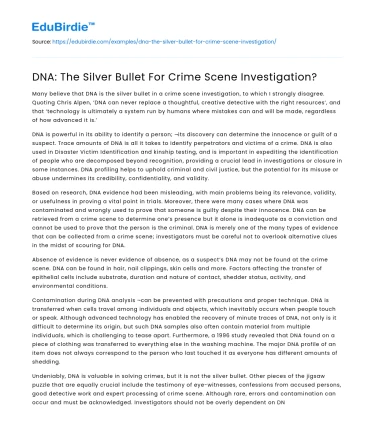Many believe that DNA is the silver bullet in a crime scene investigation, to which I strongly disagree. Quoting Chris Alpen, ‘DNA can never replace a thoughtful, creative detective with the right resources’, and that ‘technology is ultimately a system run by humans where mistakes can and will be made, regardless of how advanced it is.’
DNA is powerful in its ability to identify a person; ¬its discovery can determine the innocence or guilt of a suspect. Trace amounts of DNA is all it takes to identify perpetrators and victims of a crime. DNA is also used in Disaster Victim Identification and kinship testing, and is important in expediting the identification of people who are decomposed beyond recognition, providing a crucial lead in investigations or closure in some instances. DNA profiling helps to uphold criminal and civil justice, but the potential for its misuse or abuse undermines its credibility, confidentiality, and validity.
Based on research, DNA evidence had been misleading, with main problems being its relevance, validity, or usefulness in proving a vital point in trials. Moreover, there were many cases where DNA was contaminated and wrongly used to prove that someone is guilty despite their innocence. DNA can be retrieved from a crime scene to determine one’s presence but it alone is inadequate as a conviction and cannot be used to prove that the person is the criminal. DNA is merely one of the many types of evidence that can be collected from a crime scene; investigators must be careful not to overlook alternative clues in the midst of scouring for DNA.
Absence of evidence is never evidence of absence, as a suspect’s DNA may not be found at the crime scene. DNA can be found in hair, nail clippings, skin cells and more. Factors affecting the transfer of epithelial cells include substrate, duration and nature of contact, shedder status, activity, and environmental conditions.
Contamination during DNA analysis ¬can be prevented with precautions and proper technique. DNA is transferred when cells travel among individuals and objects, which inevitably occurs when people touch or speak. Although advanced technology has enabled the recovery of minute traces of DNA, not only is it difficult to determine its origin, but such DNA samples also often contain material from multiple individuals, which is challenging to tease apart. Furthermore, a 1996 study revealed that DNA found on a piece of clothing was transferred to everything else in the washing machine. The major DNA profile of an item does not always correspond to the person who last touched it as everyone has different amounts of shedding.
Undeniably, DNA is valuable in solving crimes, but it is not the silver bullet. Other pieces of the jigsaw puzzle that are equally crucial include the testimony of eye-witnesses, confessions from accused persons, good detective work and expert processing of crime scene. Although rare, errors and contamination can occur and must be acknowledged. Investigators should not be overly dependent on DNA for it will bring about a miscarriage of justice.






 Stuck on your essay?
Stuck on your essay?

